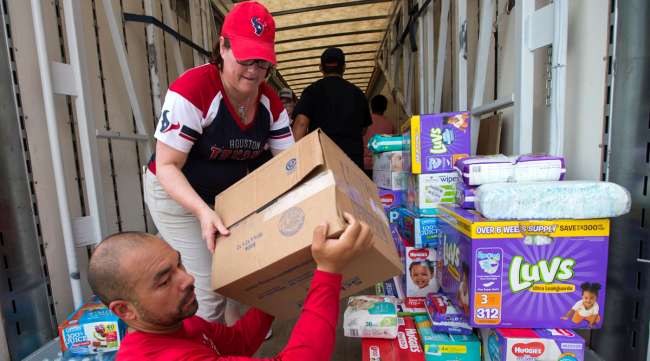Spot Market Skyrockets in Aftermath of Hurricane Harvey

In the days after Hurricane Harvey ravaged the Houston area, longhaul spot market prices tripled, in some cases, to between $5,000 and $10,000, according to conversations with truck drivers. Load board operators concurred that there was a rate spike through Sept. 5 in Texas, doubling on average in certain lanes.
On Aug. 27, Coyote Logistics and Citation Logistics offered $6,000 to $6,500 to haul relief supplies from California, Maryland and Pennsylvania, according to the DAT load board. Owner-operator Chad Boblett posted the information on Rate Per Mile Masters, a Facebook group he administers with nearly 14,000 truck drivers, brokers and other industry professionals.
Billy Hart, managing partner at Bluejay Advisors, justified the $6,000 price tag as reasonable given the business and personal risk of being on the road. He owned Hart Transportation for more than 15 years until Universal Logistics Holdings bought his commercial fleet in 2011.
“If Coyote offered $6,000, then you can also bet that they charged a 15% margin on top of it, so $7,500. Maybe even 18%. But in this type of environment many of the bigger brokers will say, ‘I’m going to get you capacity, but you have to give me a blank check,” Hart said.
Coyote, which ranks No. 5 on the Transport Topics freight brokerage sector list, would not comment on rate issues but issued a written statement.
“Drivers reported abysmal conditions along Interstate 10 in Louisiana and Texas, and we advised in many scenarios for them to take a more northerly approach into affected areas when possible at that time. Many team drivers drove as close to their delivery destinations as possible near Houston, but most needed to find a safe place to layover and wait until the roads, distribution centers and stores reopened,” it wrote.
Total Quality Logistics, No. 2 on the brokerage list, confirmed that longhauls paying more than $6,000 were consistent with the marketplace after the hurricane slammed Texas. TQL agents were working around the clock to find truck drivers to move hundreds of loads each day.
“Also, truckload capacity in general has tightened since April — there just wasn’t much excess capacity out there [to begin with],” TQL President Kerry Byrne said. “Rates have come down a bit from the first few days, but it still remains very tight, and we expect that to continue for the foreseeable future. Emergency assistance loads continue and there is a backlog of intra-Texas freight as well as regular Texas inbound that still needs to move.”
Eddie Northcraft, who drives for S and M Transportation of Shelbyville, Tenn., said that many owner-operators asked for $4 per-mile minimum — double the one-way rate — to compensate for the deadhead back home. Northcraft spotted one freight broker offering $8,700 to move mobile-only shelters from Indianapolis to Houston.
“While I saw many loads at $4 per mile, I saw some at $8 or $9 per mile coming from Indiana and Illinois. But the rates have certainly come back down to normal with rates at $3,000 for about 1,500 miles,” he said.
As to claims of price gouging, Northcraft vigorously defended truck drivers.
“I put myself and my equipment in risk when I travel into a disaster areas where other people won’t go. On one of my loads, I needed a police escort on I-10 and drove through 3-foot-high waters for 17 miles to get to my destination. Afterwards, I had to replace a tire and empty the water from several parts of my truck,” he said.
Truck driver Nathan Terry received $7 per mile to take bottled water 967 miles from Blairsville, Ga., to a Wal-Mart distribution center in Waco, Texas, from Aug. 29 to Aug. 31. One day later, he received $1300 to take hoses and generators from Waco to Houston. He also received several hundred dollars per day for layover.
“You have to know you’ll likely wait several days, in some cases, until you can get your trailer back and meanwhile you’ll be buying meals and other items while you’re waiting around,” Terry said.
Nationwide, DAT reported that prices between Aug. 29 and Sept. 5 rose 5.5% despite a 10% drop in freight volume from the week before Hurricane Harvey.
Spot market prices between Dallas and Houston averaged $990 during the week of Aug. 29 and Sept. 5, quoted as a flat rate. In the same week one year ago, it averaged $525. On a per-mile basis, the $4.00 price was the highest-ever recorded, according to DAT.
Rates from Dallas to the state’s Gulf of Mexico coastal towns, including Freeport, Galveston and La Porte, jumped from $2.02 to $4.60 year-over-year.
Longhauls from Denver to Houston climbed to $1.63 per mile, a 59-cent jump from the week before Harvey — the largest week-over-week jump in the lane in history.
Preparations are underway for Hurricane Irma, which is bearing down on Florida. Lipsey Logistics actively sought to secure dry vans and reefers to move supplies into Florida, Alabama and Georgia. The freight broker was willing to pay $4 per mile and $200 to $650 per day to cover layovers, according to an e-mail obtained by TT.

